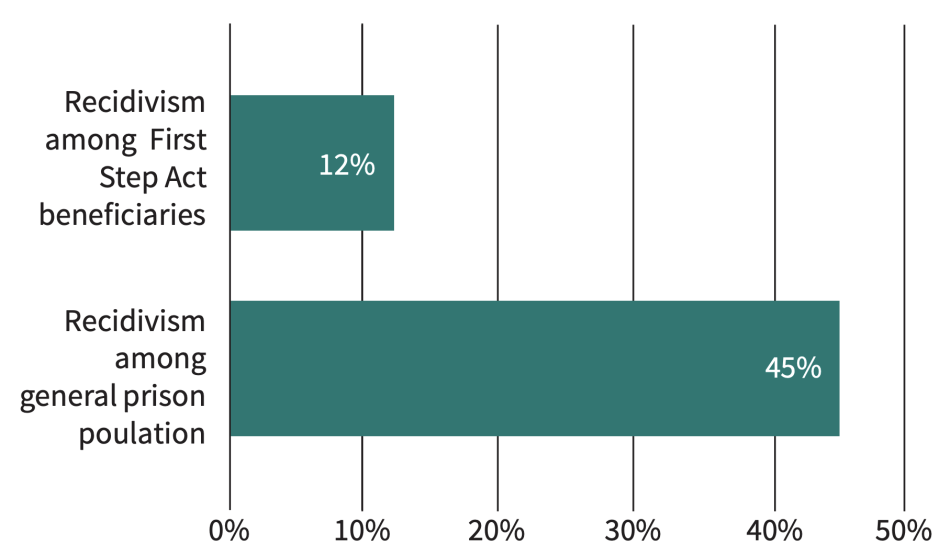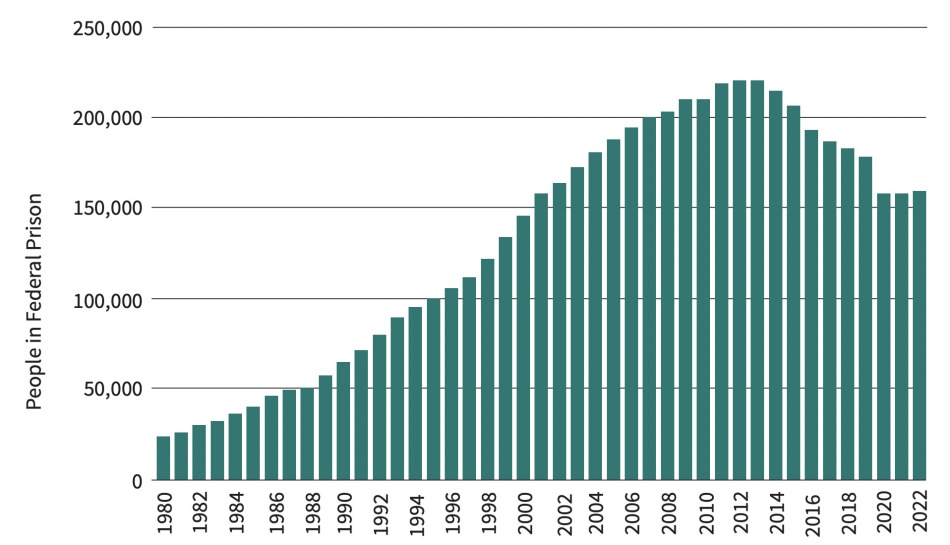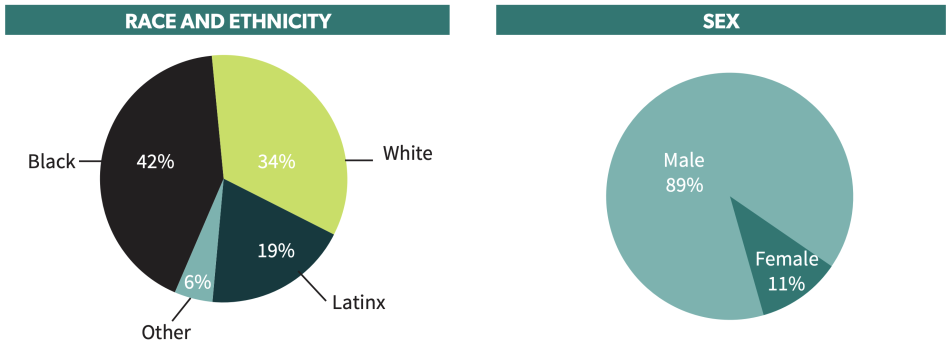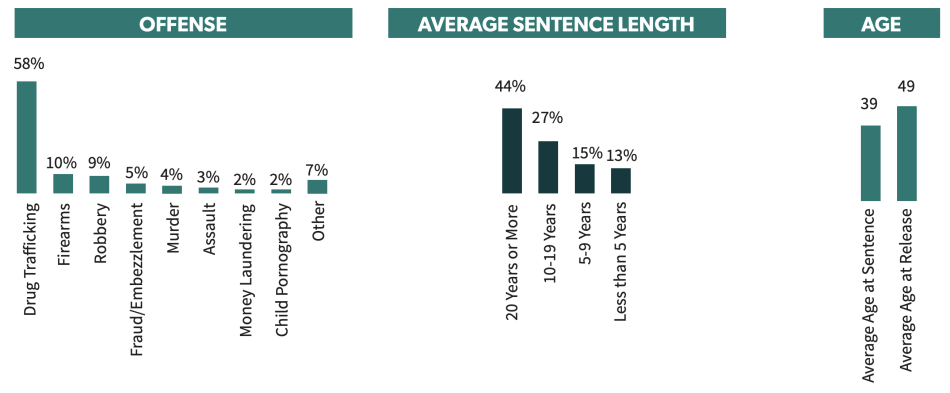
This brief describes why reforms included in the First Step Act have been deemed necessary to advance a fairer federal sentencing system and reduce the size of the federal prison population.
Related to: Federal Advocacy, Incarceration, Drug Policy, Racial Justice
In 2018, Congress passed and then-President Donald Trump signed into law the bipartisan First Step Act, a sweeping criminal justice reform bill designed to promote rehabilitation, lower recidivism, and reduce excessive sentences in the federal prison system. Lawmakers and advocates across both political parties supported the bill as a necessary step to address some of the punitive excesses of the 1980s and 1990s. 1
The First Step Act includes a range of sentencing reforms which made the Fair Sentencing Act of 2010 retroactive, 2 enhanced judicial discretion, created earned time credits, increased good time credits, reduced certain mandatory minimum sentences, and expanded the safety valve that allows persons with minor prior convictions to serve less time than previously mandated.
The First Step Act also seeks to expand opportunities for people in federal prisons to participate in rehabilitative programming to support their success after release. The law aims to produce lower odds of recidivism by incentivizing incarcerated individuals to engage in rigorous, evidence-based rehabilitation and education programming. In exchange and based on a favorable assessment of risk to the community, they may earn an earlier opportunity for release to community corrections.
The Department of Justice (DOJ) reports promising results thus far. The recidivism rate among people who have benefitted from the law is considerably lower than those who were released from prison without benefit of the law. Among the nearly 30,000 individuals 3 whose release has been expedited by the First Step Act, nearly nine in every 10 have not been rearrested or reincarcerated. 4 This 12% recidivism rate lies in stark contrast to the more typical 45% recidivism rate among people released from federal prison. 5

The majority (58%) of people released because of the First Step Act were serving time for a drug trafficking offense. 6 Within this group, 13% have been rearrested or reincarcerated since their release. Comparatively, 57% of people released from state custody for a drug trafficking conviction recidivated within three years. 7
This brief describes why reforms included in the First Step Act have been deemed necessary to advance a fairer federal sentencing system and reduce the size of the federal prison population.
The First Step Act is the result of many years of advocacy, negotiations, and compromise from a broad constituency of supporters that stretched from the White House to the prison corridors. As the name defines, it was intended as a first step toward unwinding the harms of mass incarceration at the federal level.
Due in large part to a series of draconian federal policies beginning with the Comprehensive Crime Control Act of 1984 and continuing with a range of misguided policies into the 1990s, the size of the federal prison population multiplied six-fold before beginning to fall in 2014. 8
A substantial portion of the federal prison growth was due to harsh penalties for drug offenses. 9 In 1980, sentences for drug offenses accounted for 47% of the total admissions to federal prisons; by 1991, 86% of new federal sentences were for drug offenses. 10 Indeterminate sentencing was replaced with mandatory minimums, three strikes laws, and the abolishment of parole. 11
The impact of these policies fell disproportionately on people of color, especially Black Americans, whose representation rose sharply in the federal prison population over this time. 12 At the same time that harsh sentences were favored, prison administrations mostly abandoned the notion that rehabilitation and education programming while imprisoned would lead to lower reoffending rates on release, despite strong evidence to the contrary. 13 Congress’s funding shortfalls also contributed to programming cutbacks.
The First Step Act was designed to be a multi-pronged solution to some of the most vexing problems of the federal prison system. The law expands opportunities for individuals to pursue rehabilitation and education, authorizes a range of early release mechanisms for eligible individuals to return to their families and communities, and makes retroactive the provisions of the Fair Sentencing Act of 2010 to reduce the disproportionate impact of especially harsh drug laws.

Source: Bureau of Prisons BOP: Population statistics. Accessed July 25, 2023.
The First Step Act authorized the expansion of rehabilitative and educational opportunities and incentivized eligible individuals to complete such programming. Between 2022 and 2023, the Bureau of Prisons (BOP) expanded participation in evidence-based programs and promising, prosocial activities by 35%. 4 Available programming, however, is still often inadequate to meet the needs of incarcerated individuals and the goals of the First Step Act. Just over 2,000 people in federal prison earned a GED or equivalent certificate in 2021 which, while nearly double that from 2020, 15 is still quite low. 16 The wait list for literacy program instruction in the BOP is over 28,500 people long. 17
As mentioned at the outset, the DOJ reports that between 2019 and early 2023, approximately 30,000 people have been released from federal prison before their original release date as a result of the First Step Act’s reforms. 18 Though a complete accounting of the particular components of the law responsible for these releases has not been published, the BOP reports the following figures on its website as of July 2023: 19
The First Step Act allows individuals who present extraordinary and compelling circumstances, such as severe illness and/or old age, and who pose little risk to the community, to bring their compassionate release applications directly to a federal judge 30 days after filing a petition with the BOP. 20 Compassionate release was available before 2018, but infrequently used because of its poor design and implementation challenges. 21 , Section 603 of the Act amended section 3582(c)(1)(A) of title 18 to authorize “defendants” (i.e., imprisoned people) to file a motion for compassionate release “after the defendant has fully exhausted all administrative rights to appeal a failure of the Bureau of Prisons to bring a motion on the defendant’s behalf or the lapse of 30 days from the receipt of such a request by the warden of the defendant’s facility, whichever is earlier.”)) The ability for individuals to personally petition the court is a substantial departure from the previous policy, which mandated that only the BOP director could file a motion on behalf of an individual. This rarely occurred. In a 2016 report, the Office of the Inspector General chastised the BOP for its remarkably low grant rate: only 3% of compassionate release applications were granted in that year. 22 Similarly low grant rates have been reported by the US Sentencing Commission. From 2013 to 2017, the BOP received 5,400 requests for compassionate release and approved only 6%. Taking an average of 4.5 months to issue a decision on these applications proved deadly, as 5% of the applicants died while waiting to learn the outcome of their plea. 23
The First Step Act rightly amended this segment of the law and since its passage, 4,560 people have returned to their communities and families because of it. 24 In its first year, 2019, 55 people were granted release. As the COVID-19 pandemic spread through prisons, this part of the law became a lifesaving device for many, helping to preserve the health of elderly and medically vulnerable individuals. The grant rate among people applying for compassionate release rose to 27% in the height of the pandemic. The Commission found that for individuals granted compassionate release in 2020, reductions in sentence were significant, with an average reduction of nearly 5 years or nearly 40% of an individual’s sentence. Following this rise, the grant rate fell to 12% and 13% in 2021 and 2022, respectively. Still, a larger overall number of qualified people have been released because of expansion of this mechanism.
| Year | People Released | Grant Rate |
|---|---|---|
| 2019 | 55 | 3% |
| 2020 | 2,611 | 27% |
| 2021 | 1,399 | 12% |
| 2022 | 585 | 13% |
Sources: Sawyer, K. H. (2020, February 3). [Letter to Representative Jerrold Nadler].; U.S. Sentencing Commission. (2023). U.S. Sentencing Commission compassionate release data report.


Recent data provided by the Commission reveals that beneficiaries of compassionate release had been identified by the BOP as low-risk, and more than half were convicted of nonviolent drug offenses. Two-thirds of recipients were people of color. Over 40% had originally been sentenced to at least 20 years in prison before their release, as noted by the data reported for the first quarter of 2023.
The First Step Act expanded the BOP’s authority to place individuals in home confinement by reauthorizing and expanding a pilot program for elderly individuals convicted of nonviolent offenses and terminally ill individuals. The Act also encouraged the BOP to make greater use of home confinement by requiring the BOP, to the extent practicable, to place individuals with lower risk levels and lower needs on home confinement for the maximum amount of time permitted under under Section 3624(c)(2), which authorizes home confinement for 10% of the term of imprisonment or six months, whichever is shorter. This authority was temporarily expanded with the passage of the CARES Act in March 2020, which authorized the Attorney General to expand eligibility in order to reduce spread of COVID-19 in federal prisons. 25 Under this expansion, more than 12,000 people in federal prison were released to home confinement. 26 July 2023 figures from the BOP show that 7,293 people were serving their sentence at home under this provision. 27
The Fair Sentencing Act of 2010 lowered the notorious disparity in mandatory minimum drug quantity triggers for crack vs. powder cocaine offenses from 100:1 to 18:1. But it failed to make this change retroactive, leaving thousands of individuals, disproportionately Black Americans, in federal prisons serving sentences that Congress had deemed unjust. The First Step Act rectified this, making the changes of the Fair Sentencing Act retroactive. People convicted of certain offenses involving crack cocaine can now seek to have their sentence reduced as if the Fair Sentencing Act’s revision via the First Step Act had been in effect at the time the offense was committed. 28 The Commission reports that 4,000 people have been given a reduced sentence as a result. 29
A 2022 Commission report of released people notes that 92% were Black and 98% were male. Half had been sentenced between the years 2006 and 2010 and on average, beneficiaries of retroactivity received a 24% reduction in their sentence, amounting to a release date 72 months sooner. 30
Individuals in federal prisons earn good time credits for good behavior, described as “exemplary compliance with institutional disciplinary regulations.” The First Step Act expanded good time credits by specifying that incarcerated individuals can now earn up to 54 days of good time credit for every year of their imposed sentence. Prior to the amendment, BOP interpreted the good time credit provision in Section 3624(b) to mean that individuals are eligible to earn 47 days of good time credit for every year of their imposed sentence.
Additionally, the First Step Act created earned time credits, which allow eligible people in federal prisons to earn credits for participation in rehabilitative programs and activities. These credits can be applied toward extra community-based programming (such as a halfway house and home confinement). A long list of disqualifying offenses 31 limits this reform from its full potential effectiveness, as does the slow and disorganized process for recognizing and attributing earned credits to time-served. 32
The First Step Act reduced the length of some mandatory minimum sentences prospectively, giving judges more discretion in sentencing. For example, the Act reduced the 20-year mandatory minimum sentence for drug trafficking with one prior conviction to 15 years, and eliminated its mandatory life-without-parole (LWOP) sentence for drug trafficking to 25 years among those with two or more prior convictions. The Act also eliminated the “stacking” provision, which allowed prosecutors to charge individuals with a second and subsequent use of a firearm in furtherance of a drug trafficking or violent offense in the same criminal incident, which, if convicted, carried a 25-year mandatory minimum. Now, the mandatory minimum only applies when the individual has a prior conviction for use of a firearm in furtherance of a drug trafficking or violent crime from a previous criminal prosecution.
The First Step Act expanded the so-called safety valve provision, which allows courts to sentence people convicted of low-level, nonviolent drug crimes with minor criminal histories to less than the required mandatory minimum sentence.
The First Step Act has suffered from numerous challenges in implementation which have limited its impact and effectiveness. As previously mentioned, the BOP has failed to provide adequate rehabilitative programming and swiftly calculate and accurately apply earned time credits. Delays in developing a tool to automatically determine an individuals’ earned time credits has resulted in people remaining in prison past their earned release dates. Lengthy waitlists for programs prevent individuals from earning the maximum potential number of credits. The BOP has also, at times, adopted policies contrary to the plain text of the Act and the will of Congress – deeming, for example, in a since-revised 33 memo, that release dates become fixed 18 months prior to release, and additional credits earned will not hasten an individual’s release. 34
Likewise, the Bureau of Prisons has faced criticism for its use of a flawed and biased risk instrument. For eligible individuals earning time credits, a risk score affects both the number of time credits individuals can earn and how they can redeem them. The risk score reflects both static and dynamic factors including an individual’s criminal history and disciplinary record. Individuals who receive lower risk scores earn more days than those who are assessed as having a higher risk of recidivism. The tool, PATTERN, 35 that has been used to calculate this risk score has received significant criticism for its overestimation of risk and its worsening of racial disparities. 36 Researchers at the National Institute of Justice have produced a series of analyses that guide improvements to this tool. The latest iteration of the tool – PATTERN 1.3 – attempts to correct for scoring and coding errors identified in earlier versions of the tool. It is expected that these corrections and continued analysis of the tool’s impact will reduce racial and ethnic disparities. 37
The full promise of the First Step Act has yet to be realized. Robust and equitable implementation is necessary to fulfill the Act’s mandate and ambitious goals.
During the 1980s and 1990s, the enactment of harsh mandatory minimums and sentencing enhancements led to a prison system that incarcerated far too many people who posed little risk of community harm, with especially dramatic effects on Black Americans. 38 The First Step Act has been a critical means of reducing excess incarceration while prioritizing community safety. Because the First Step Act has been viewed largely as a successful first step, lawmakers would be wise to expand it. Bipartisan groups have urged Congress to build on the provisions of the First Step Act, including by passing the bipartisan First Step Implementation Act, the Safer Detention Act, and the EQUAL Act. 39
The First Step Implementation Act would make key provisions of the First Step Act retroactive. When it passed the First Step Act in 2018, Congress made clear that it considered some mandatory minimum sentences too long and shortened them. The First Step Implementation Act would extend that relief to people sentenced prior to the First Step Act’s passage, creating opportunities for individuals serving lengthy mandatory minimum sentences for certain drug offenses and “stacked” gun offenses to seek a shorter sentence aligned with what they would receive today. The bill would also allow courts to consider sentence reductions for people who committed crimes under the age of 18 and have served at least 20 years behind bars.
The Safer Detention Act would correct a significant flaw in the First Step Act. Currently the First Step Act arbitrarily excludes the oldest people in federal prisons – those convicted prior to November 1, 1987 – from applying to courts for compassionate release. The Safer Detention Act would make them eligible, while also allowing elderly people who have served the majority of their sentence, and who the BOP deems low risk, to return to their families via the elderly home detention pilot program.
Finally, the EQUAL Act would expand upon the First Step Act’s cocaine sentencing reform provisions by prospectively and retroactively eliminating the infamously racist disparity in mandatory minimum thresholds between crack and powder cocaine.
Meanwhile, the BOP must continue to work to fully implement the First Step Act and its equitable administration. 40 Access to rehabilitative programming remains inadequate and a lack of transparency has plagued the rollout of earned time credits. The BOP must ensure that the First Step Act achieves its full rehabilitative potential.
Krent, H. J. & Rucker, R. (2022). The First Step Act–Constitutionalizing prison release policies. Rutgers University Law Review, 74(2), 631-676.
The Fair Sentencing Act of 2010 (FSA), enacted August 3, 2010, reduced the statutory penalties for crack cocaine offenses to produce an 18-to-1 crack-to-powder drug quantity ratio. The FSA eliminated the mandatory minimum sentence for simple possession of crack cocaine and increased statutory fines.
U.S. Department of Justice. (2023). First Step Act annual report. Unfortunately, comprehensive data identifying which components of the law contributed to an individual’s release have not been released, and the Department of Justice reports that mechanisms by which one might be released are not necessarily mutually exclusive.
U.S. Department of Justice. (2023), see note 3.
U.S. Government Accountability Office. (2023). Federal Prisons: Bureau of prisons should improve efforts to implement its risk and needs assessment system.
Drug trafficking encompasses a wide range of conduct, from street-level possession with intent to distribute to high-level, organized drug distribution.
Durose, M., & Antenangeli, L. (2021). Recidivism of prisoners released in 34 States in 2012: A 5-year follow-up period (2012–2017) – Table 5. Bureau of Justice Statistics.
Federal Bureau of Prisons. Population statistics. Accessed July 25, 2023.
Mauer, M. (2001). The causes and consequences of prison growth in the United States. Punishment & Society, 3(1), 9–20. https://doi.org/10.1177/14624740122228212.
Beck, A., & Gilliard, D. (1995). Prisoners in 1994 – Table 16. Bureau of Justice Statistics.
National Research Council (2014, 2023), see note 11.
U.S. Department of Justice. (2023), see note 3.
Bureau of Justice Statistics (2022), see note 15.
This total includes 17,096 U.S. citizens and non-U.S. citizens. See, U.S. Department of Justice. (2023). FY 2024 Performance Budget Congressional Submission.
U.S. Department of Justice (2023), see note 3.
Federal Bureau of Prisons. Population statistics. Accessed
July 25, 2023.
Section 3582(c)(1)(A) of title 18, United States Code.
The First Step Act of 2018 (Pub. L. No. 115-391 (2018
U.S. Department of Justice, Office of the Inspector General (2017). The impact of an aging inmate population on the Federal Bureau of Prisons. https://oig.justice.gov/reports/2015/e1505.pdf.
Greenblatt, J. P. (2021). In search of judicial compassion: The Cantu-Lynn divide over compassionate release for federal prisoners. Columbia Human Rights Law Review, 52(1), 141-202.
U.S. Sentencing Commission. (2023). U.S. Sentencing Commission compassionate release data report. A similar composition of the compassionate release population was reported in 2020.
The Department of Justice reports that “only a fraction” of these individuals have been returned to prison for new criminal conduct. See: US Department of Justice, Office of Public Affairs (2023). Final rule issued for home confinement under the CARES Act.
U.S. Department of Justice, Office of Public Affairs (2023), see note 25.
Federal Bureau of Prisons (2023). BOP: COVID-19 home confinement information, frequently asked questions. Accessed July 25, 2023. The BOP reports 6,054 people serving their time on home confinement and another 1,239 people on “elderly home confinement” which is a similar component limited to older people.
U.S. Sentencing Commission (2022), see note 29.
The Brennan Center reports that more than half of the prison population does not qualify for programming because of their crime of conviction. See, Grawert, A. C. & Richman, P.L. (2022). The First Step Act’s prison reforms: Uneven implementation and the path forward. The Brennan Center.
Grawert, A. C. & Richman, P. L. (2022), see note 31.
This acronym stands for Prisoner Assessment Tool Targeting Estimated Risk and Needs.
Labrecque, R. M., Hester, R., & Gwinn, J.(2023). Revalidation of the First Step Act risk assessment: A test of predictive strength, dynamic validity, and racial/ethnic neutrality. Crime & Delinquency, 0(0). https://doi.org/10.1177/00111287231180106.
U.S. Department of Justice. (2023), see note 3
EQUAL stands for “Eliminating a Quantifiably Unjust Application of the Law Act of 2023”.
Grawert, A. & Richman, P. (2022), see note 31.
Krent, H. J. & Rucker, R. (2022). The First Step Act–Constitutionalizing prison release policies. Rutgers University Law Review, 74(2), 631-676.
The Fair Sentencing Act of 2010 (FSA), enacted August 3, 2010, reduced the statutory penalties for crack cocaine offenses to produce an 18-to-1 crack-to-powder drug quantity ratio. The FSA eliminated the mandatory minimum sentence for simple possession of crack cocaine and increased statutory fines.
U.S. Department of Justice. (2023). First Step Act annual report. Unfortunately, comprehensive data identifying which components of the law contributed to an individual’s release have not been released, and the Department of Justice reports that mechanisms by which one might be released are not necessarily mutually exclusive.
U.S. Department of Justice. (2023), see note 3.U.S. Government Accountability Office. (2023). Federal Prisons: Bureau of prisons should improve efforts to implement its risk and needs assessment system.
Drug trafficking encompasses a wide range of conduct, from street-level possession with intent to distribute to high-level, organized drug distribution.
Durose, M., & Antenangeli, L. (2021). Recidivism of prisoners released in 34 States in 2012: A 5-year follow-up period (2012–2017) – Table 5. Bureau of Justice Statistics.
Federal Bureau of Prisons. Population statistics. Accessed July 25, 2023.Mauer, M. (2001). The causes and consequences of prison growth in the United States. Punishment & Society, 3(1), 9–20. https://doi.org/10.1177/14624740122228212.
Beck, A., & Gilliard, D. (1995). Prisoners in 1994 – Table 16. Bureau of Justice Statistics. National Research Council (2014, 2023), see note 11. U.S. Department of Justice. (2023), see note 3. Bureau of Justice Statistics (2022), see note 15.This total includes 17,096 U.S. citizens and non-U.S. citizens. See, U.S. Department of Justice. (2023). FY 2024 Performance Budget Congressional Submission.
U.S. Department of Justice (2023), see note 3. Federal Bureau of Prisons. Population statistics. AccessedU.S. Department of Justice, Office of the Inspector General (2017). The impact of an aging inmate population on the Federal Bureau of Prisons. https://oig.justice.gov/reports/2015/e1505.pdf.
Greenblatt, J. P. (2021). In search of judicial compassion: The Cantu-Lynn divide over compassionate release for federal prisoners. Columbia Human Rights Law Review, 52(1), 141-202.
U.S. Sentencing Commission. (2023). U.S. Sentencing Commission compassionate release data report. A similar composition of the compassionate release population was reported in 2020.
The Department of Justice reports that “only a fraction” of these individuals have been returned to prison for new criminal conduct. See: US Department of Justice, Office of Public Affairs (2023). Final rule issued for home confinement under the CARES Act.
U.S. Department of Justice, Office of Public Affairs (2023), see note 25.Federal Bureau of Prisons (2023). BOP: COVID-19 home confinement information, frequently asked questions. Accessed July 25, 2023. The BOP reports 6,054 people serving their time on home confinement and another 1,239 people on “elderly home confinement” which is a similar component limited to older people.
Federal Bureau of Prisons. First Step Act. U.S. Sentencing Commission (2022), see note 29.The Brennan Center reports that more than half of the prison population does not qualify for programming because of their crime of conviction. See, Grawert, A. C. & Richman, P.L. (2022). The First Step Act’s prison reforms: Uneven implementation and the path forward. The Brennan Center.